|
This
is part two of the coverage of the American control Line Championships
that began in the January 1962 edition of American Modeler.
Part one covered mainly control line stunt and combat. Part two
covers team racing and speed, carrier, jets, and scale. I was amazed
to read about how many large scale jobs suffered structural failures
varying in nature from wings breaking to landing gear collapsing.
The multi-engine models had enormous amounts of trouble getting
everything working properly. Believe it or not, one top speed contestant
had his winning engine stole out of his model while it was sitting
unattended in the flight box. There have always been scumbags.
See part one of the
American Control Line Championships. American Control Line
Championships (part 2)
Jet, Speed, Proto, Scale, Carrier, Team RacingWilliam Nezeband
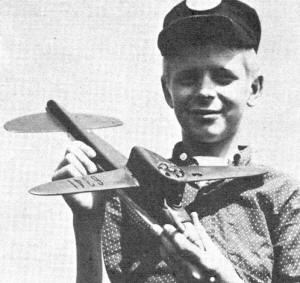
Eddie Roberts, Huntsville, Alabama, with his record-setting
Class "8" speed entry. Fox 29X power. Original design. E.R.,
11 during Nats, had been U/C'ing 2 years.
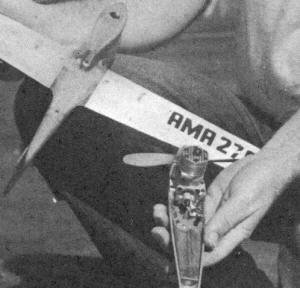
Jim Nightingale's FAI speed job; international flavor with
MVVS Czech engine. Metal tank, unpressurized fuel. Original,
molded epoxy fiberglass top, metal wing.
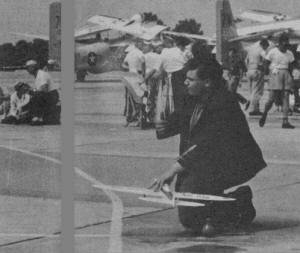
What well-dressed FAI Team Racing man wears. Natty suit,
extra prop strapped to wrist. We're learning.
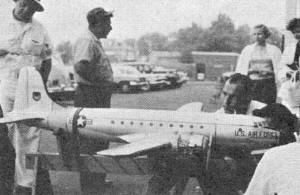
C-54 was trio approach. Had everything but right balance
and right fuel feed.
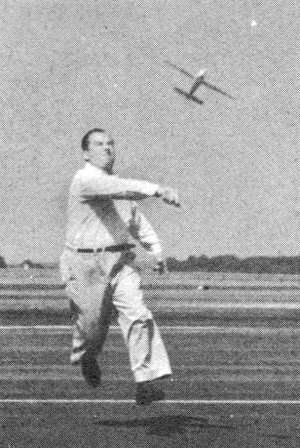
John V. Kukon, speed official, launches A-job for son.
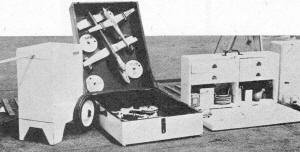
Portion of John Kukon's estimated 5,000 bucks worth of speed
equipment and models. He competes in every class.
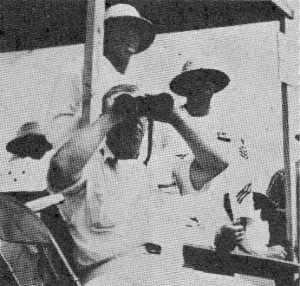
Binocs keep Navy CPO check whipping and flight heights.
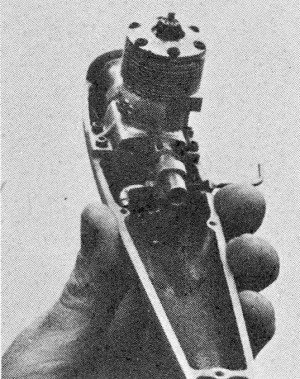
Howler .15 plant built by Cincinnati's Craig Asher, used
by Lauderdale in Europe on '60 USA team. |
Ever stand around. trying to get the "feel" of a speed contest.
You watch models whiz by, watch pilots pedal the pylon, watch the
watch... and still you're on the outside looking in. These guys
have something special to work with. The airplane becomes a vehicle
to hold their pet engine up (and back). Most of their development,
secrets, ad-vances are covered by or included on the case of their
engine. Their fuel can con-tains a matched set of volatile ingredi-ents
which give them the power. From a spectator's viewpoint
speed is the easiest to understand. The contestants are trying to
go as fast as possible. Speed is a universal language. To list the
ingredients that caused the winners to win would involve Ouija boards
plus slide rules. Don't be surprised if another year we cover the
Nats with a portable laboratory as well as yardstick and camera.
In case the point has already dulled, the meat of a speed job is
in the engine, fuel, prop, glo plug, humidity, tempera-ture and
such. These aren't too visible to an observer even on a clear day.
Also who was the last guy to let you measure and time HIS engine?
General observations on what brand of engine won which event can
become slightly limp, since most receive careful hand work and custom
fitting. Judging by the activity, speed is still on the
rise, which is a healthy sign. Speed is to CL as FF gas is to FF
in general. It's the event with class break-down where similar methods
and tech-niques payoff in several events. The dedicated speed flyer
has 6 categories in which to operate, and a large number of them
do. John Kukon is an example of this type. He has well built models,
a spare engine in each class which is tested, performance recorded
and ready to go. Each model has recorded data - when peak performance
occurs, no more flying is necessary. Several plush-lined boxes hold
models and a complete set of tools. Me Kukon Sr hand launches and
the pair do a heap of flying. Mr. K. Sr was speed Co-Director with
Pitt Hartzell. John estimated $5,000 worth of equipment has been
used to build up the stable of "Hummingbirds." His record this Nats
in Open: 3rd in ~A; 2nd in A; 3rd in B; 5th in C; 3rd in Jet. 5
more trophies for that already crowded mantel. Jim Nightingale
is always good for an unusual arrangement. His FAI job features
fiberglass top, non-pressure "Chick-en Hopper" tank, an MVVS engine
from Czechoslovakia. Flight is reminiscent of the early days with
lap after lap of in-creasing whiz until the engine hits peak, the
hand is dropped into the pylon, and speed is timed. Fred Randell
showed us a Howler 15 (remember?) used by Lauderdale in Europe in
'60. This engine was built up by Craig Asher of Cincinnatti. Fred
was exhibiting some special pen bladder type tanks with thicker
walls. He had designed them and was having same made by Goodyear.
In B all records were upped, as were the 3 Proto marks.
Young Eddie Roberts, Huntsville, Alabama took the Jr. B record and
first with 138.73, then 2nd in A, and 3rd in Proto. He's been flying
2 years, pretty good in local circles, and Dad helps. It's encouraging
to see these kids getting their hands greasy. 'Twas good to note
Ed Rankin back in business, picking up a 3rd in Proto. Ed has charge
of the CL contest board and in years past has been awfully consistent
about directing speed affairs. Gotta bust loose and fly some time.
Had decided to unmention the impounding of Proto ships bettering
33 seconds, but many people are aware of it, without knowing the
facts. An anony-mous rumor (the worst kind) contended that some
oversize engines were being used in Proto. It had to be stopped,
so models in top places were snatched and that evening were measured
carefully. Ralph Biddle is an inspector by trade so accurate measurements
were performed with special tools so the engines didn't have to
be broken down. All engines were okay except a Super Tigre that
calculated to .3005 which falls right between .300 and .301. So
where do you put it? The boys started out "A" day by seeing
how much whipping would be allowed. On B day there was no whipping.
John and Pitt set up a little differently from most. One batch of
timers worked both circles, with two ready areas and alternate flights.
System worked fine after bogging down that first day. One judge
with 7x50 binoculars threw down on each pilot and also observed
the ele-vation pole. One word from him and time was nullified. Once
the limit was set, no more trouble. Saturday was ½A
time and it was flown ROW. Woody Blanchard almost lost a foot race
to his drifting ship before it went down a drain. Others washed
away or splashed. Didn't think a "Peanut" would float. Reason for
flying thru the monsoon was an early cut-off time to allow the Navy
air show. Then that show was grounded and the sun came out 'round
11 :30 so all events were run til 6 :00. Half-A is becoming somewhat
limited since only two engines, the Hornet and TD are around anymore.
Speeds are still good with Warren Kurth turn-ing 102.46 in Open.
The blow torch types continue with Nash and Pardue
running their Lit' Burp at 164.02 to edge out Harry Latshaw's 161.81.
Harry is one of the best jet men in the country, holder of the record
sev-eral times. His ship is being kitted by Elimination Models.
One note to speed and FF types interested in RPM:
Warren Kurth-Larry Conover had some ruggedized tuned reed tachometers
built up. A box about 1½ x 1½ x 6" contains precision
tuned reeds and is direct reading from around 16000 to 24000. Price,
not settled, may be around 50 bucks. One sour note
was the expert and callous theft of Fred Carter's winning 139 mph,
Supertigre 15. The thief did a very thorough job, opening a model
box, selecting the A model, removing the top, unscrewing the engine,
replacing the screws and the top, then closing the box. Fred was
offering $50 for information leading to the capture, $25 for return
"no questions." These speed engines are valuable, sport fans.
Navy Carrier is popular on the East and West Coasts,
so-so in the Midwest. We'll see at Chicago about progress in '62,
but there were beaucoup carrier jobs at Willow Grove. In fact I
counted 50 ships holed up in the hangar during the Saturday rain.
Dick Simpson set up two carriers and kept both busy, some. during
rain and lots of action afterwards. I suppose the local area has
their own interpretation of the slow speed rules, and since they
were also running the event-. What constitutes smooth
prototype characteristics has always been subject to variance. Since
90% of the engines were Mac 60's it was a noisy day. Such a loud
whomp with these heavy ships. Three years ago when I put flaps on
a Guardian you couldn't have sold them for nuthin. This year everyone
dumps out flaps and enjoy the extra lo-speed lift. Robert's Maulers
were thick as fleas at a hobo dog show and I finally saw enough
Roberts control systems to believe it's been discovered. Only took
6 years too! Heard some rumble after 3 flights were
allowed on Saturday while they operated two carriers, then using
only one carrier on Sunday to accommodate 50 plus open contestants.
With early cut off time only one flight was allowed. Sudden death-like.
Of course, Sunday brings events that probably sapped the man power
available or something. All is neither black nor white when scheduling
these meets and allocating officials. Consolidated's
new Dark-Shark looks like a good carrier ship, at least the sev-eral
advance models at the Nats flew well. There were a number of Avengers.
one of which was flown to Open victory by George De Angelo of Brooklyn
with a rosuinv 508 score. 60 throttles seem to have been worked
out and pressure (10) is being used. First three places in each
Carrier group went to the East Coast bunch. From Brooklyn
came a real razzle-dazzle bunch with side-line coaching and the
works. It's obvious that they take Carrier seriously. Actually aside
from the precipitation, weather was excellent for Carrier operations
with 10 breezes just right for playing at low speed. Most experienced
pilots can get lower speed in a breeze than in dead air. It is most
encouraging to see so much activity in this advanced event. (If
we can establish a 35 class, now, things should really boom.)
FAI Team Racing was held as a Nats event this year
for the first time and a fair group showed up. Counted 18 teams
on the board early in the day. Anyone spectating this event is advised
to pick the upwind side of the circle. Diesel fuel has a distinct
odor. Was particularly impressed by the rigid safety regulations.
There's an outer circle where pit crews are not allowed and an inner
circle where pilots must remain. Pilots must resemble gentlemen
while flying with handle press-ed closely to their breast. OR else
Henry Nichols from England, one of the authorities on team racing
was running things with an iron hand. Some of our teams, not yet.
up on the fine points, were heavily reminded by instant action.
The speeds turned were nothing exceptional, not nearly as good as
overseas. However, we are many years behind in diesel experience.
Our teams are now breaking under 5 minutes, so we're getting there.
Models all seem to fit a standard pat-tern of short coupled,
large wing. and stab. Since the mechanic cannot enter the circle,
some jobs use a wheel only on the inboard side and drag the outboard
tip to keep headed out. If the model spins into the circle, there
you sit. Bob Watts ship, River's powered, snagged a line on a tar
blob and did just that, delaying him enough to lose his heat. Bill
Ayers won the final with an Oliver Tiger powered entry. Heats looked
rather calm with an absence of snarling engines, but when we get
up to the century mark it should be pretty exciting. The zoned landing
says you move into the quadrant behind, so mechanics spot themselves
on the line, catch the model and quickly set it back. You cannot
be any closer to another plane on the ground than ¼ lap,
so take off tangles aren't too prevalent. It happens tho, Standard
pit equipment is a spare prop strapped to the wrist and a fuel bulb.
Didn't see any glo equipment being used. Paul Burke took time off
from being chief processor to fly this event. While it is evident
that we Americans need more experience, we have made considerable
progress in the few years our dedicated few have been interested.
Since the event calls for precise building, it may never be overwhelmingly
popular via the numbers, but it certainly has its place.
Those saying B Team Racing is dead may be wrong. Small and elite
maybe, but not dead. Since I had to catch an airplane early Sunday
wasn't able to see this run personally. Again perhaps, Nationals
participation is not a judge of popularity. There were a goodly
number of excellent ships entered with the Stin-son's (Jr &
Sr) operating the event. It is interesting to note that Bob Huffer
who won this year was the pilot of George Moir's standout winner
of the 1954 Nats. A lot of experience brought to bear this year.
Would say that B-TR has its place in things also. See the CL Capers
for more dope.
Spent
some time looking over the Scale jobs; found some outstanding subjects
for controversy. First off, the event is for Flying Scale. As seems
to be usual, the highly detailed ships had difficulty garnering
their just rewards because they could not get their flights in.
Reasons seem to fall into categories: (1) Scale builders
don't seem to be flyers and as a rule botch things through pilot
error. (2) Models are fabulously detailed to the point of
excess weight, without re-gard for center of gravity location. An
overweight, tail-heavy model is destined for the bone yard before
the first flip of a prop. (3) Gross disregard for engine
type, and fuel system. Tanks are placed anywhere and although progress
is being made, sick engines are still in evidence. (4) Related
to (I), plain old ignorant mistakes in pre-flight preparation.
(5) Disregard for good stress consid-erations. (6)
Lack of flight testing before the big contest. The
C-54 Skymaster illustrates some of these points. Gardner, Astle
and Bonamie teamed up to prepare a fabulous model and an equal presentation.
An automatic slide projector and recorder played slides made of
the finished interior photographed using mirrors. Electrical system
was 4½ volts (regulated yet) with all instrument panels lighted
internally, cabin lights, electric power winch, cargo door. Flaps &
gear operated and flight sequence (automatically controlled from
the model) included opening cargo door, running out grapple, pick
up glider, drop glider, close door, dump flaps and gear, throttle
engines. The cargo consisted of scale crates of M1 Rifles with markings.
Fire extinguishers didn't operate. A real winner, eh? On the debit side: CG was around 50% chord. Tail heavy. Tanks were
under scale vents and fuel was plumbed as far as 6 inches up hill
(against centrifugal force). These two drawbacks could have been
avoided by consideration of aerodynamics and practical items. It
took major time to get engines operating before Sunday since they'd
not been checked before. On flight attempt it did what any experienced
CL man would expect. Stalled off and plowed in. Bill
Ogden had a beautiful 1" equals 1' B-25 which would have been a
shoo-home winner. Bill evidentally needs more time on a trainer
(he was working out evenings). This flight was spectacular to say
the least. Pulled off too quickly it stalled and hit, only to be
headed for the judges. Off again to miss personnel only to flop
again and head for the pits. This time he committed the unpardonable
CL sin, that of hauling the lines in hand-over-hand. The gear finally
collapsed killing the engines. Bill cut his hand severely (it was
a 12½ lb airplane). The handle had not been neutralized.
Really, Bill. So his son flew the second flight which went off nicely,
but score was voided - W.O was not permitted a proxy flyer. A full-house Handley-Page bomber showed lack of respect for air-loads
by folding its outboard panels after several laps and disintegrating
all over the place. A 16-lb B-25 suffered from overenthusiastic
detail and under-power, stalling off and mushing in folding gear
and props. Simple details, and some flying at home might have changed
the picture completely. Joe Coles of Mt. Holly, N.
J., won open Scale and the Testors Award with his usually excellent
workmanship and an F3J. Joe specializes in jets and superb scale
finishes, having won the Testors award several times. He properly
weathers paint, stains exhaust openings, and puts on all of the
little detail lettering that make a modem jet. One big point, his
models always fly nicely. H. C. (Ray) Randall, one
of the scale judges, and one of my informants on scale operations,
would like to get in touch with the builder of the Curtiss Kingbird.
Seems that you disappeared after your fine flight. Ray was impressed
with the model and says with a few changes it'll be almost perfect.
Something about right engine exhaust on the left side and NC before
your wing numbers. Write to him thru AM. Okay? So
the Nats go, one after the other, each with its own character and
memories. Lasting impression are the important ones and after all,
while it's a multi-ring circus, it is the place where everyone can
come without reservation. You can see anything there and usually
do. You find nastiness from unexpected sources and much courtesy
and camaraderie from equally unsuspected places. Going to dinner
one eve with Ralph and Eva Biddle (you should see Karen now), and
Bud Tenney, I popped off with Gordon Gabbert's famous line "Smile
- It's only a Hobby." Almost got my head tom off at the roots. Running
things from an Event Director's level brings a new insight to competition.
Am still convinced though. "It is a hobby." Isn't it?
Posted November 9, 2013
|



